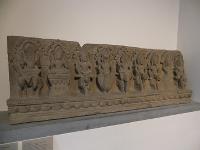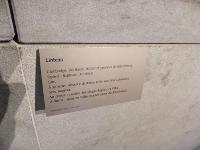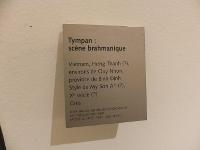***
France/Spain 2011
Day 5 - 21st March - Paris: Musée Guimet - Southeast Asia (Part 6)


The Nine Deva. Cambodia. Final quarter of 10th-Start of 11th c.


Lintel. Cambodia. 11th c.

"In the 12th century, the Khmer armies of Suryavarman II, founder of Angkor Wat, invaded Cambodia, occupying it for four years. The counterattack was mounted by Jaya Indravarman of Gramapura, an ally of China and Vietnam, who in turn occupied Angkor and Cambodia"
This shows the ignorance of blind nationalistic appeals to history, with the Khmers invading Cambodia.


Tympan: brahmanic worshipper. Vietnam. 13th-14th c.


Dragon-makara. Vietnam. End of 12th-Start of 13th c.



Tympan: brahmanic scene. Vietnam. 10th c (?)


"The cham inscriptions frequently mention the offering of precious covers of this type - a kind of enclosing sheath, protecting and magnifying the linga in store which is the most sacred aspect of the god Siva venerated in an abstract form of phallic origin"
Groin guards. Vietnam. 8th c.



Siva. Vietnam. 11th-12th c.
The Chinese influence on post-Champa Vietnam is clear: not just Chinese characters, but the artefacts are basically inferior copies of Chinese ones (the horrible china is one example).



Bodhisattva Avalokitesvara (x2). Vietnam. 18th, 17th-18th c.


Hideous funerary model (fortified farm). Vietnam. 1st-3rd c.


Pair of Altar Candlesticks. Vietnam. 1579.



Altar lamp, Dragons. Vietnam. 1637 or 1697 / End of 16th-17th c.



Makara. Indonesia. 14th-15th c.


Agastya (?). Indonesia. 8th-9th c.


Warding Buddha Maravijaya. Burma. 18th-19th c.
This is "Buddha who vanquished Mara". I don't know why he looks like a ki
I think this was the first time I'd seen Burmese art.

Thai Buddhas


Wheel of the Law (dharmacakra). Thailand. 8th or 9th.


Sutra Cupboard. Thailand. 19th c.


Warding Buddha. Cambodia. 19th c.


Corner pilaster. Cambodia. 16th c.


God. Cambodia (?). 12th c.


Lintel. Cambodia. Middle of 12th c.


Vaishnavite monument. Cambodia. First 3/4 of 12th c.


Balustrade corner. Cambodia. Second half of 12th c.


Balustrade corner. Cambodia. First 3/4 of 12th c.


Asura. Cambodia. End of 12th/Start of 13th c.
The Asuras "constitute a group of power-seeking deities, sometimes considered sinful and materialistic. The Daityas and Danavas were combinedly known as Asuras. The Asura were opposed to the Devas. Both groups are children of Kasyapa".


Asura. Cambodia. End of 12th/Start of 13th c.
Although this was the Southeast Asian gallery, Cambodia was over-represented. Partly this was due to colonial history, but I don't think I saw a single Laotian item there - even though Laos was part of French IndoChina. But then Laotian history only really started in the mid-14th century.